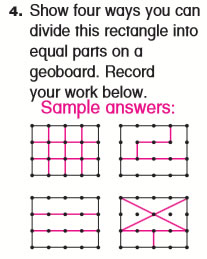
1. Look at these sample answers to a problem about making fractions on a geoboard (from Everyday Mathematics grade 3)
a. Tell what fractions are shown in each diagram
b. How could you prove that the parts shown in each diagram are equal?
c. In what ways are the two diagrams on the right different from the diagrams on the left?
2. On your geoboard, or on geoboard dot paper, find several more ways of showing thirds and fourths on the same rectangle shown in the previous problem (4 spaces wide by 3 spaces high)
3. What is a shape that it is hard to find different ways to divide it in half? What is a shape that it is easy to find different ways to divide it in half?
4. If you use a yellow hexagon (from your pattern block set) to represent a whole, what fractions are easy to represent? What shapes would represent them?
5. Explain, using the same ideas emphasized in the grade 3 fraction standards, what 3/4 means. Draw a number-line diagram to help your explanation.
6. Explain, using the same ideas emphasized in the grade 3 fraction standards, what 4/3 means. Draw a number-line diagram to help your explanation.
7. Tell a fraction that is equivalent to 3/4. Draw a rectangle-diagram to help your explanation.
8. Tell a fraction that is equivalent to 3/4. Draw a number-line diagram to help your explanation.
9. Tell a fraction that is equivalent to 2. Draw a number-line diagram to help your explanation.
10. Describe at least two different ways that children might solve the problem of 6 children sharing 8 brownies.
11. Explain how to compare two fractions that have the same denominator. (Make sure you include the "why it works" not just the "how to do it")
12. Explain how to compare two fractions that have the same numerator. (Make sure you include the "why it works" not just the "how to do it")